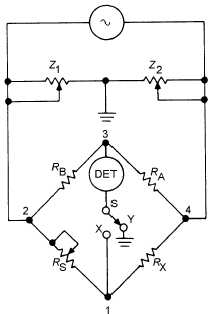3-5
Figure 3-4.—Wagner ground.
Many bridge instruments provide terminals for external excitation potentials; however, do not use a
voltage in excess of that needed to obtain reliable indicator deflection because the resistivity of electronic
parts varies with heat, which is a function of the power applied.
Q-1.
What conditions must be met in order to balance a bridge circuit?
Q-2.
When you are measuring a component using a bridge, what is the most common cause of
inaccurate measurements?
Wheatstone Bridge
The Wheatstone bridge, shown in figure 3-1, is often used to measure resistance. These instruments
are usually portable because they require only a small, dc source to power the bridge, which is easily
obtained from flashlight batteries. In those cases where an external supply voltage is desirable for the
operation of the bridge, use the minimum voltage that will give a reliable indication by the galvanometer.
Increasing the supply voltage any further results in uncompensated thermal variations and decreased
bridge accuracy. If greater bridge sensitivity is needed, use a galvanometer with greater sensitivity.
A number of other considerations are involved in the choice of a galvanometer. For example, the
galvanometer should not be subjected to false or erratic indications because of external magnetic fields.
This requirement dictates the choice of a shielded meter mechanism. It is also desirable to use a critically
dampened meter movement to ensure decisive movement of the meter pointer during conditions of bridge
unbalance. Thermal agitation sometimes produces voltages that interfere with the balancing of the bridge.
For this reason, the Wheatstone bridge usually includes a polarity-reversing switch in the detector circuit.
When a measurement is required, note the reading for both positive and negative indications, and figure
the average of both readings. With the exception of inaccuracies introduced by thermal variations (caused
by excessive supply voltages), the accuracy of the Wheatstone bridge is, otherwise, independent of the
value of supply voltages. The units used in calibrating the galvanometer are unimportant to the accuracy
of the bridge, since a 0 indication is desired at the balanced condition.

